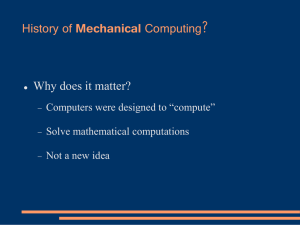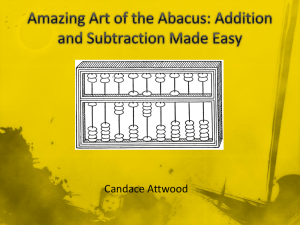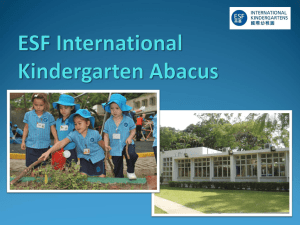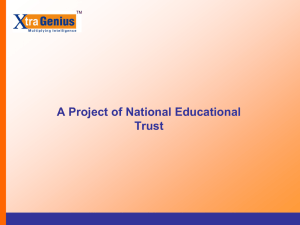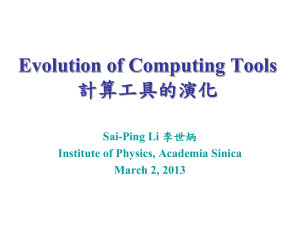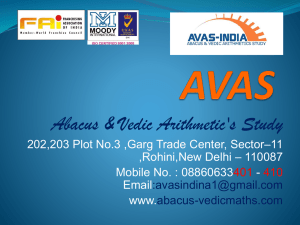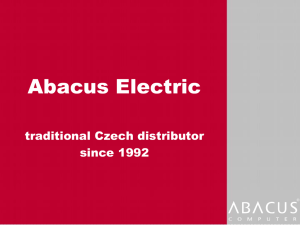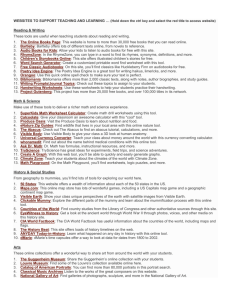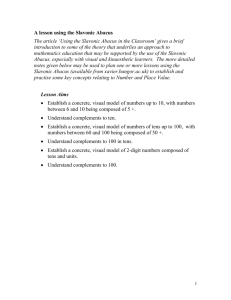Design Proposal of learning environment from the cognitive
advertisement
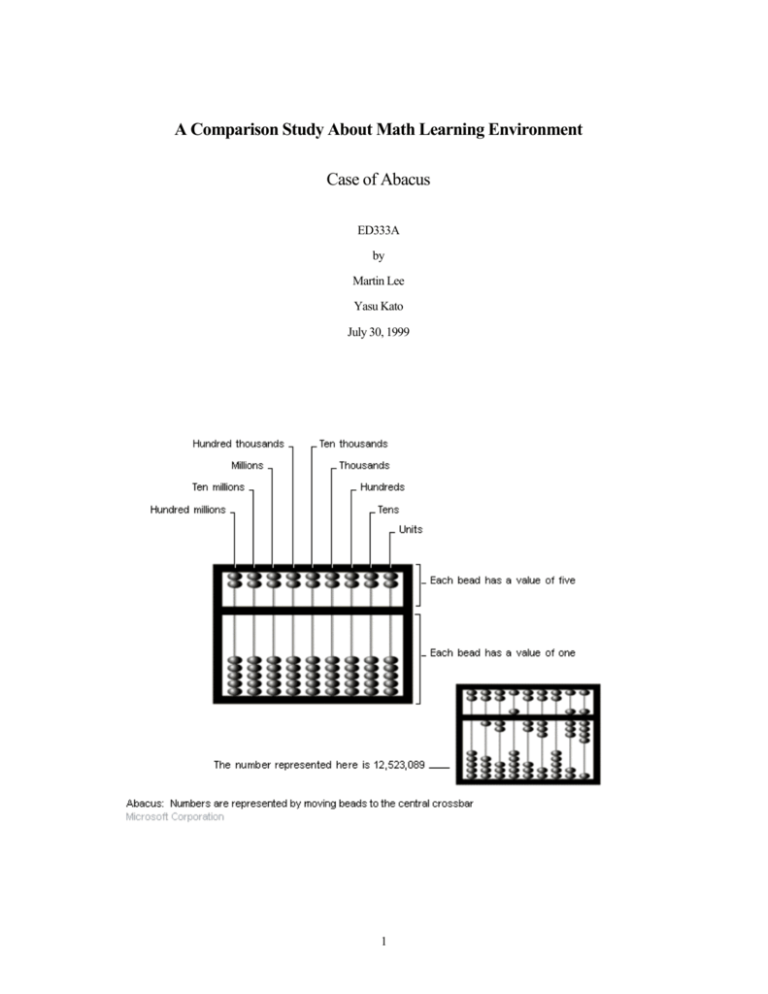
A Comparison Study About Math Learning Environment Case of Abacus ED333A by Martin Lee Yasu Kato July 30, 1999 1 A Comparison Study About Math Learning Environment 07/30/99 Martin Lee Yasu Kato Background In our previous proposal, we presented two preferences in learning--learn from models, which we called module-based learning, and learn from concept, which we called it concept-based learning. The firs preference, learn from models, students learned the procedures as a model, made repeated practice, and remembered some kind of formula to master the procedures. After memorizing these models, students then build their conceptual models from the models their minds. The second perspective, learn from concepts, students learned a concept first, and then practice the procedures by applying the concept. The previous proposal was more focus on the cognitive perspective and our study might be narrowly focused. Proposal In this proposal, we would like to review those two perspectives previously presented from a different perspectives—The behaviorist. We will present a case of learning of basic math using abacus and we would like to suggest a further study of multiple learning approach for a single teaching subject. Learn to Think or Learn to Do Generally speaking, American education promotes learning to think more productively and more flexibly. In contrast many Asian countries are trying to teach students to do things faster and better. This led two results in education. People who learned to think are more creative in idea and invention. People who learned to do are better in production, modification and improvement, based on an existing condition. To be flexible and creative is very important in most social and humanity sciences application. The concept-based learning provides a rapid understanding and helps learner to use analogy to solve math problems. This learn-to-think approach perhaps is the most productive learning style for most social and humanity sciences. However, this learning approach might be questionable in learning exact sciences such as math. Basic math requires the construction of math skill and ability to handle fractions, 2 decimals, and rules for addition, subtraction, division, and multiplication. In order to be fluent, it requires not only the understanding of the general concepts of the math but also logic, memory of rule sets, and computational skills. Which learning preference is the most effective style depends on science, topic, grade, teacher, culture, and the situation. In order to design an effective learning environment for basic math education, a longterm study is need. This study should identify the learning situation and analyze the learning effectiveness and outcomes of different teaching approaches from different perspectives. Case of Abacus There are some discussions about the decreasing tendency of math skills in K-12 schools all over the world. We here present a case of abacus to illustrate the differences of learn by concept and learn by rules. We will first analyze the learning hierarchy of mastering abacus, and then we will discuss the learning structure and the design from behaviorist perspectives. Analysis Learning abacus has somehow an interesting strategy. First, students learn the concepts of calculation and apply the concepts to abacus. Second, they learn rules for addition, subtraction, and other basic calculation rules including mastering chart from one multiply by one to nine multiply by nine. Finally, they will be able to handle abacus with speed and accuracy as a result of concept and stimulus-response learning. Learning how to use abacus might be seem as a single process of learning but if we analyze it deeply, we might see that it has included three basic theories that is the cognitive, behaviorist, and situative. Student will begin with the basic few beads, which can be count one by one till four. This learning gives students a clear understanding of the number of objects and its relation to whole numbers. This is also the social model of counting by having each object as a whole. For students to recognize the relation in between objects and whole numbers might be more focus on cognitive perspective. However, most of the children might have already had a clear understanding of this cognition from social practice, which might be categorized by situative learning. 3 After a clear understanding of the whole numbers represented by single beads, students will have to learn that a single bead can represent multiple quantitative values. Students will have to learn to recognize the same bead in a different way which is very different from the previous understanding. Student will have to learn to memorize that the same beads depend on its position it represents different quantities. Some might represent a group of five and some might be representing a group of 50, 500 or more. This memorization, or this part of the learning process is learning by rules and can be explained from the behaviorist perspective. Next, students will learn the manipulation of upper deck beads. Students, after learning about the beads from two different perspectives, now can manipulate the operation of carry over on the abacus. In this phase, students make repeated practice of calculation of addition, subtraction, multiplication, and division. Until they can do the operation without thinking, they have to make practices. It’s a combination of stimulus-response learning and chaining. Eventually, students can calculate without a real abacus. They have an internal model of an abacus and activate the model by picking up fingers in the air or on the desk. The finger touch enhances the response of stimulus-learning from behaviorist perspectives. However, students still will need a concrete cognitive model of an abacus in their mind and this model has to be highly dynamic and interactive with an infinite number of digits. (Of course there are limitations, but an abacus expert can calculate more digits than a real abacus has.) After all, students can calculate without any physical actions. In their minds, many beads are going up and down and executing the calculation. User Study To investigate the effectiveness of abacus in school math education, we have to make a long-term experiment. The target subjects are 3rd grader to 12th grader. Whether student can learn math from abacus or learn abacus form math is a case of interest. The learning focus on the concept of the math or the skill of computational abilities through the manipulation of abacus is also a interest of the study. After experimental trials, by interviewing students and math assessment, math problem solving comparison, we will have a better understanding about the teaching approach and its product. We categorized this learning hierarchy into three stages master abacus. 4 1. First stage: Basic skills In this stage, students identify the basic concept of abacus and manipulate basic operation of beads and performing calculation. Of course, they should have concrete concepts of whole number and calculation method. 2. Second stage: Virtual abacus I In this stage, students can perform calculation without abacus. But they need physical reaction from their finger / the object (desk or notebook, etc.) 3. Third stage: Virtual abacus II In this final stage, students can perform calculation without any physical reactions and responses. They make a virtual abacus in their mind. They can image beads and their finger and execute calculation. Assessment The assessment will begin with the first and second stage of abacus learning. In these two stages, physical response (stimulus-response learning) makes an important role to master abacus. Three different groups of experimental students will be tested. 1. Full abacus At 3rd grade, students start to learn abacus and continue until 4th grade. At 5th and 6th grade, they have a big challenge of virtual abacus I. 2. Half abacus At 3rd grade, students start to learn abacus and continue until 4th grade. Then, they don’t use abacus anymore. 3. No abacus This group will be taken a standard math curriculum. No special abacus is added to this curriculum. In every certain period of time, all experimental groups will be tested by the math calculation ability and math problem solving ability. We expect the result will help us to better understand the 5 difference in teaching math with focus on single perspectives, multi-perspective consecutively, multiperspective concurrently. 6
